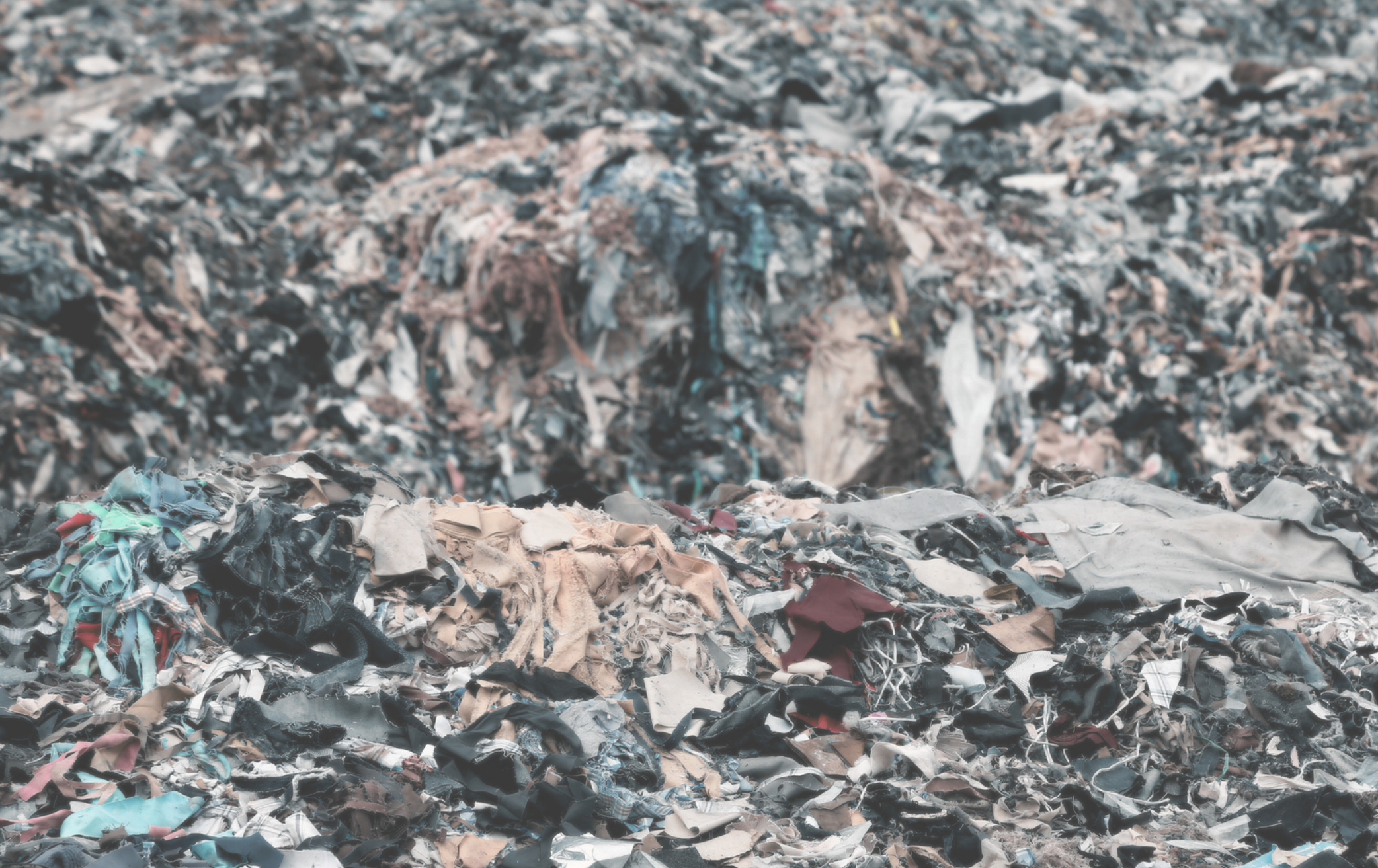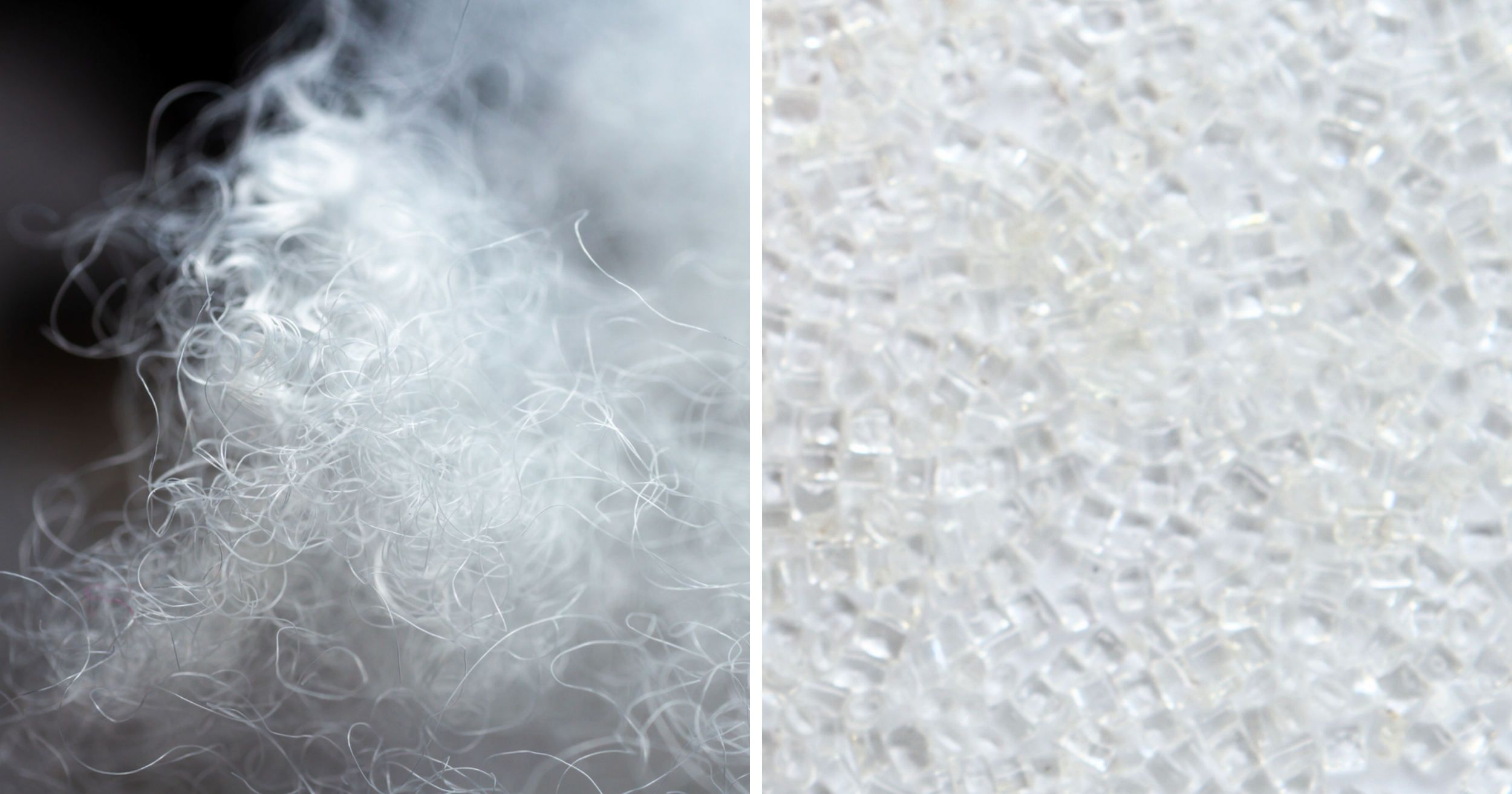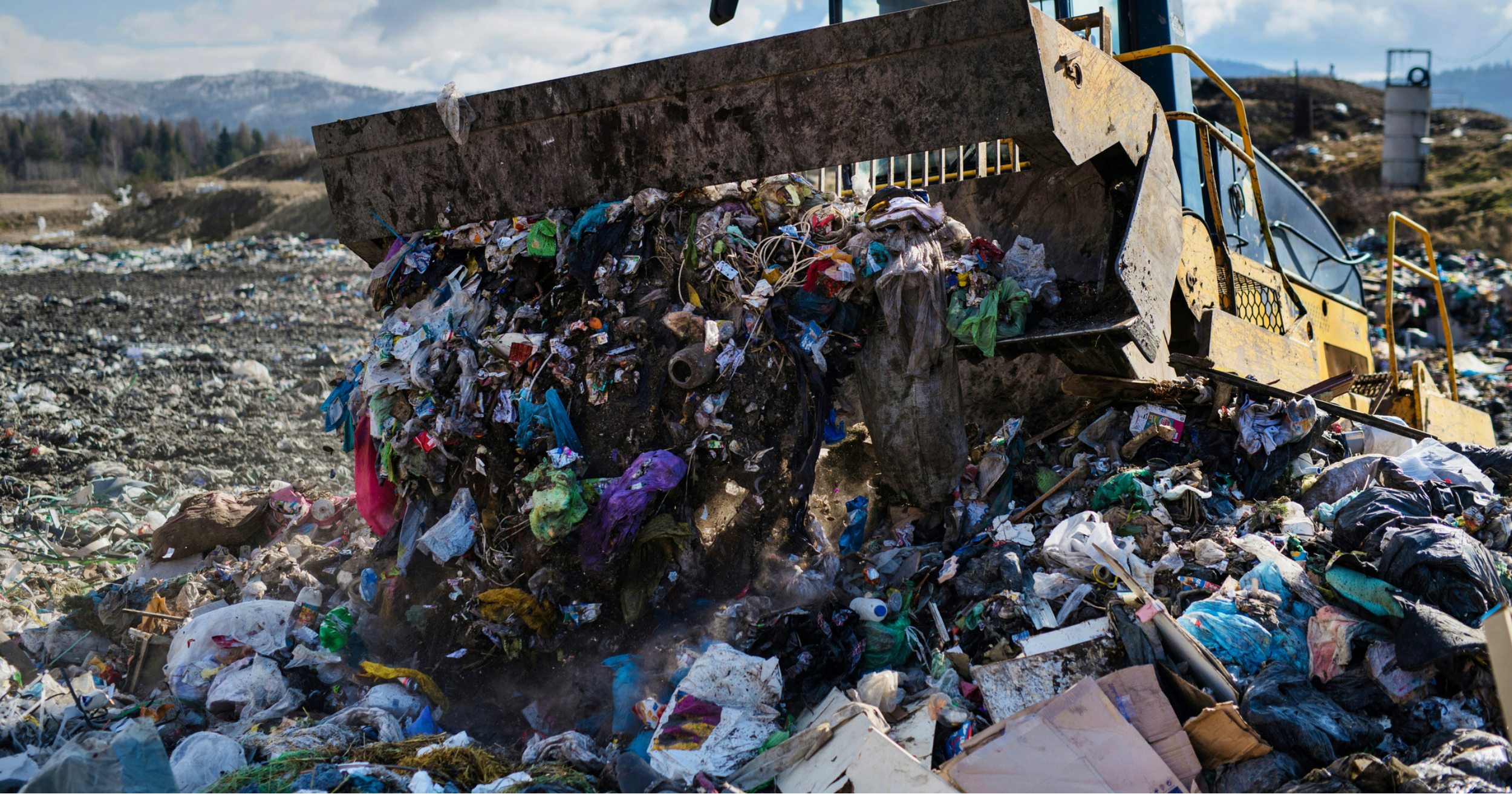
Waarom is fast fashion polyester een probleem?
Terwijl wij worstelen met slappe papieren rietjes, produceert de fast fashion industrie elk jaar miljoenen tonnen plastic kleding.
Fast Fashion Polyester
Dus, wat is het probleem met polyester? Het zit overal in onze kleding, het kan zich zelfs voordoen als natuurlijke vezels.
Satijn? Nee, dat is geen zijde, het is een weefstijl voor een zijdeachtige afwerking. En ja, satijn is meestal polyester.
Fleece? Dat is pluizig polyester.
Velours? Harig polyester.
Crêpe? Gekreukt polyester.

100% polyester labels van fast fashion kleding.
Wat is polyester?
Polyester is een stof die van plastic wordt geweven.
Ja, hetzelfde plastic dat wordt gebruikt voor dingen als flessen en voedselverpakkingen. Dit PET-plastic wordt verwerkt van plastic chips of pellets tot een vezel die kan worden geweven tot een materiaal.

Polyestervezels en PET-kunststofkorrels, twee kanten van dezelfde medaille
De geschiedenis van polyester
Polyester werd uitgevonden aan het begin van de 20e eeuw en zoals veel moderne technologie, maakte het grote sprongen in zijn ontwikkeling in de jaren 30 en 40 vanwege de veranderingen in de industrie tijdens de Tweede Wereldoorlog. Natuurlijke vezels waren beperkt verkijgbaar en mensen moesten het doen met wat ze hadden vanwege de kledingrantsoenering.
Dus toen er een stof werd uitgevonden die geproduceerd kon worden uit ruwe olie, zonder de leveringsproblemen die katoen en wol hadden, sloeg het enorm aan. Vrij van die beperkingen en revolutionair in zijn eigenschappen, was polyester het antwoord op alle kledingproblemen.

PET plastic chips, hetzelfde materiaal waarvan kleding wordt gemaakt
Waarom dragen we kleding van plastic?
Het grote voordeel van polyester ten opzichte van natuurlijke vezels was dat het goed was- en opvouwbaar was zonder te kreuken of krimpen. Het kon op manieren worden geproduceerd die het waterbestendig of vochtafvoerend maakten. Dit in tegenstelling tot natuurlijke vezels zoals katoen of wol, die water absorberen en dan zwaar worden, en langzaam drogen.
Opeens hoefde sport- en zwemkleding niet meer van slappe wol te worden gemaakt. We konden jassen dragen die ons droog hielden zonder zwaar en gewaxt te zijn.
Polyester kon zonder enige zorg worden gewassen en vervolgens opgehangen om in een paar uur te drogen. Het hoefde niet gestreken te worden, wat een hoop werk scheelde.
Het was revolutionair, maar "jurken van plastic" zouden zelfs in de jaren 50 moeilijk te verkopen zijn geweest. Het klinkt niet bepaald comfortabel.
Polyester kreeg dus flitsende nieuwe merknamen en werd op de markt gebracht als de redder in nood voor alle kledingproblemen in het leven. En hoewel het een fantastische stof is om practische redenen, met name kleding voor sport en (slecht) weer, heeft het één groot nadeel.
Waarom wordt er in fast fashion zoveel polyester gebruikt?
Als 70% van de kleding tegenwoordig van polyester is gemaakt, moet daar een reden voor zijn.
-
Polyester is goedkoop
-
Polyester imiteert dure materialen
-
Polyester is snel en eenvoudig massaal te produceren
In tegenstelling tot natuurlijke vezels kan polyester snel in fabrieken worden geproduceerd. Het verkoopmodel van fast fashion vereist dat de voorraad snel wordt aangevuld met nieuwe stijlen. Polyester kan snel genoeg in elkaar worden geflanst om elke stijl te creëren en in te spelen op onmiddellijke veranderingen.
Dit alles maakt polyester tot het perfecte materiaal voor de huidige, razendsnelle modemarkt.
Het grote probleem met polyester
Zoals we tot nu toe hebben laten zien, is polyester plastic, en zoals je waarschijnlijk weet, vergaat plastic niet — in ieder geval niet voor honderden jaren. Ondertussen stapelt het zich gewoon op in stortplaatsen en op stranden in het Zuidelijk halfrond.
Of het wordt verbrand. Verbrand om te proberen er vanaf te komen, waarbij giftige dampen en vervuiling vrijkomen die nooit echt weggaan.

Plastic vergaat niet, en dat geldt ook voor polyesterkleding.
De fast fashion plastic catastrofe
Mode ging vroeger in seizoenen, en daarvoor zelfs jaren. In het afgelopen decennium zijn we van 4 seizoenen aan trends per jaar naar 52 wekelijkse trends per jaar gegaan.
De huidige vraag naar nieuwe mode is zo hoog dat alleen materialen die snel en goedkoop kunnen worden verkregen en in kleding kunnen worden omgezet, hieraan kunnen voldoen. Er is gewoon geen tijd om ethische of duurzame materialen te verkrijgen en deze in trends om te zetten met de snelheid waarmee we ze consumeren.
Als de vraag naar nieuwe mode zo hoog blijft, zal het aanbod polyester blijven gebruiken.
Maar het is niet alleen een vraagprobleem. Modebedrijven creëren deze trendcyclus om ons te pushen om te kopen, kopen, kopen. We hebben niet vaker dan eens per seizoen of minder nieuwe kleding nodig, maar ze kunnen een buzz creëren rond een trend waardoor je het gevoel krijgt dat je iets nieuws nodig hebt om er ook bij te horen.
Sterker nog, naar schatting produceert de industrie 40% meer kleding dan consumenten daadwerkelijk kopen. Veel van deze overtollige kleding, vaak gemaakt van polyester of andere synthetische stoffen, wordt verbrand of gestort, voordat het ook maar ooit gedragen is.
En vanwege de slechte kwaliteit van fast fashion is een aanzienlijk deel ervan niet geschikt voor hergebruik en recycling. Ongeveer 1% kan worden gerecycled en 12% wordt gedowncycled voor vodden en restjes. De rest is alleen maar goed voor afvalbak.
Volgens een recent onderzoek in Amerika weet 69% van de mensen niet dat hun kleding van plastic is gemaakt. De crisis blijft daardoor onopgemerkt.

Moet ik stoppen met het kopen van polyester?
Nee, je hoeft niet te stoppen met het kopen of dragen van polyester. Als we stoppen met het gebruiken van de polyester kleding die we al hebben, kan het nergens heen. Het zou leiden tot een overweldigende hoeveelheid gedumpt plastic.
Polyester is een stof met geweldige eigenschappen. We hebben het nodig voor sportkleding, zwemkleding en weerbestendige kleding. Maar dat betekent niet dat we nieuwe polyesterkleding moeten kopen.
Met zoveel polyester kleding al op de wereld, is de beste keuze altijd om tweedehands te winkelen. Koop polyester kleding tweedehands wanneer het mogelijk is. Dit vermindert de vraag naar nieuwe polyester kleding en houdt tegelijkertijd bestaande kleren uit de vuilstort.
Hoe zit het met microplastics die vrijkomen bij het wassen van polyester?
Er is geen perfecte manier om de vervuiling door het wassen van polyester kleding aan te pakken, maar er zijn momenteel verschillende microplastic waterfilters op de markt om de hoeveelheid die in de oceanen terechtkomt te verminderen.
Je kunt kiezen uit microplasticfilters die je aan de slang van de wasmachine kunt bevestigen, of zakken waarin je je synthetische kleding in de wasmachine kunt doen.
Het opnieuw dragen van tweedehands polyester kleding heeft nog steeds de voorkeur boven het volledig vermijden ervan. Want als iedereen stopt met het dragen van polyester, kan het nergens anders heen dan gedumpt of verbrand worden.
Hoe zit het met gerecycled polyester?
Fast fashion merken promoten het gebruik van gerecycled polyester in een poging ons ervan te overtuigen dat ze nu duurzaam zijn.
Helaas is dat niet het geval. Bekijk hier onze blog over waarom gerecycled polyester niet duurzaam is.
Waar kun je tweedehands kleding kopen?
Bij ThriftTale willen we mode daadwerkelijk duurzaam maken. We kopen afgedankte kleding op en brengen deze terug in de wereld voor echte circulaire mode.
Onze collectie vintage en tweedehands kleding zit vol met kwaliteitsartikelen die een kans op een tweede leven verdienen. Van designermerken tot unieke handgemaakte vintage stukken, we laten de wereld zien dat je niet per se gloednieuw hoeft te kopen - je kunt duurzaam én stijlvol zijn in tweedehands.










